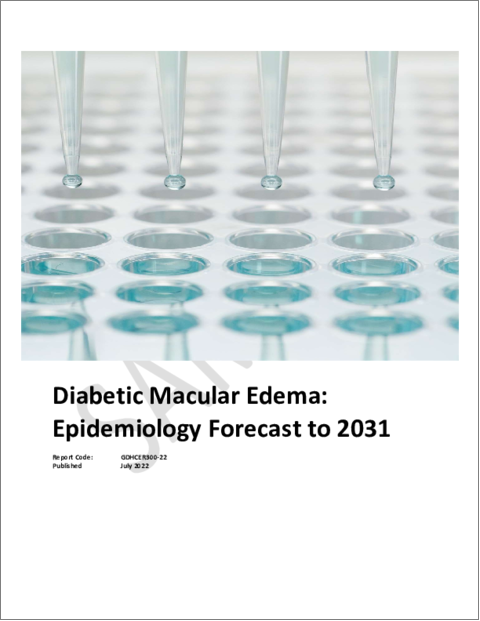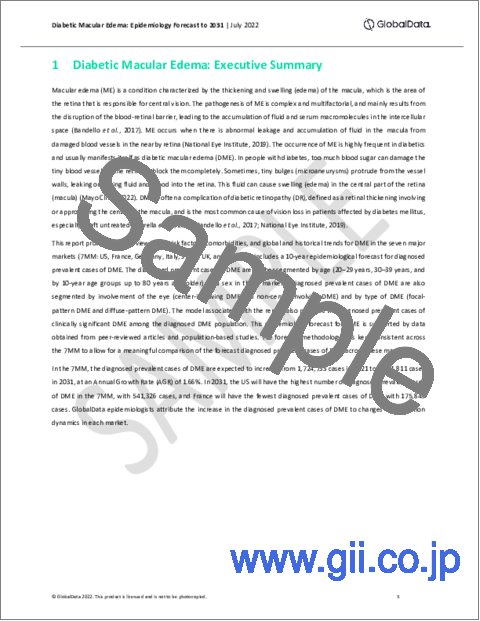|
|
市場調査レポート
商品コード
1121464
糖尿病黄斑浮腫の疫学分析および予測:2021年~2031年Diabetic Macular Edema Epidemiology Analysis and Forecast, 2021-2031 |
||||||
|
● お客様のご希望に応じて、既存データの加工や未掲載情報(例:国別セグメント)の追加などの対応が可能です。 詳細はお問い合わせください。 |
|||||||
| 糖尿病黄斑浮腫の疫学分析および予測:2021年~2031年 |
|
出版日: 2022年07月28日
発行: GlobalData
ページ情報: 英文 27 Pages
納期: 即納可能
|
- 全表示
- 概要
- 図表
- 目次
7MM(米国、フランス、ドイツ、イタリア、スペイン、英国、日本)において、糖尿病黄斑浮腫(DME)の診断された有病例の数は、2021年の174万4,395例から、2031年までに203万1,337例へと増加し、予測期間中にAGRで1.64%の成長が予測されています。7MMでは、男性が女性よりも有病例数が多く、高齢者が主に罹患しています。
当レポートでは、世界の糖尿病黄斑浮腫について調査し、主要な7MMにおけるDMEの危険因子、合併症、世界・過去の疫学動向、DMEと診断された有病例の10年予測(年齢(20歳以上)、性別、眼病、DMEのタイプにより区分)に関する情報を提供しています。
目次
目次
第1章 糖尿病黄斑浮腫:エグゼクティブサマリー
第2章 疫学
- 疾患の背景
- 危険因子と合併症
- 世界・過去の動向
- 7MMの予測調査手法
- 情報元
- 予測の前提条件と方法
- DRと診断された人口の中でDMEと診断された有病例
- DMEと診断された有病例:眼病別
- DMEと診断された有病例:タイプ別
- DMEの疫学的予測(2021年~2031年)
- DRと診断された人口の中でDMEと診断された有病例
- DRと診断された人口の中でDMEと診断された有病例:年齢
- DRと診断された人口の中でDMEと診断された有病例:性別
- DMEと診断された有病例:眼病別
- DMEと診断された有病例:タイプ別
- 討論
- 疫学的予測の洞察
- COVID-19の影響
- 分析の限界
- 分析の強み
第3章 付録
- 参考文献
- 著者について
- 連絡先
List of Tables
List of Tables
- Table 1: Summary of newly added data types
- Table 2: Summary of updated data types
- Table 3: Risk factors and comorbid conditions associated with DME
List of Figures
List of Figures
- Figure 1: 7MM, diagnosed prevalent cases of DME, both sexes, N, ages ≥20 years, 2021 and 2031
- Figure 2: 7MM, diagnosed prevalence of DME (%), men and women, ages ≥20 years, 2021
- Figure 3: 7MM, sources used and not used to forecast the diagnosed prevalent cases of DME
- Figure 4: 7MM, sources used to forecast the diagnosed prevalent cases of DME by involvement of the eye
- Figure 5: 7MM, sources used to forecast the diagnosed prevalent cases of DME by type
- Figure 6: 7MM, diagnosed prevalent cases of DME, N, both sexes, ages ≥20 years, 2021
- Figure 7: 7MM, diagnosed prevalent cases of DME by age group, N, both sexes, 2021
- Figure 8: 7MM, diagnosed prevalent cases of DME by sex, N, ages ≥20 years, 2021
- Figure 9: 7MM, diagnosed prevalent cases of DME by involvement of the eye, N, both sexes, ages ≥20 years, 2021
- Figure 10: 7MM, diagnosed prevalent cases of DME by type, N, both sexes, ages ≥20 years, 2021
Macular edema (ME) is a condition characterized by the thickening and swelling (edema) of the macula, which is the area of the retina that is responsible for central vision. The pathogenesis of ME is complex and multifactorial, and mainly results from the disruption of the blood-retinal barrier, leading to the accumulation of fluid and serum macromolecules in the intercellular space (Bandello et al., 2017). The occurrence of ME is highly frequent in diabetics and usually manifests itself as diabetic macular edema (DME). In people with diabetes, too much blood sugar can damage the tiny blood vessels in the retina or block them completely. DME is often a complication of diabetic retinopathy (DR), defined as a retinal thickening involving or approaching the center of the macula, and is the most common cause of vision loss in patients affected by diabetes mellitus, especially if left untreated (Petrella et al., 2012; Bandello et al., 2017; National Eye Institute, 2019).
This report provides an overview of the risk factors, comorbidities, and the global and historical epidemiological trends for DME in the seven major markets (7MM: US, France, Germany, Italy, Spain, UK, and Japan). The report includes a 10-year epidemiology forecast for the diagnosed prevalent cases of DME. The diagnosed prevalent cases of DME are further segmented by age (20 years and older), sex, involvement of the eye (center-involving DME and non-center-involving DME) and by type of DME (focal-pattern DME and diffuse-pattern DME). The following data describes epidemiology of DME. In the 7MM, GlobalData epidemiologists forecast an increase in the diagnosed prevalent cases of DME from 1,744,395 cases in 2021 to 2,031,337 cases in 2031, with an AGR of 1.64% during the forecast period. Men accounted for more diagnosed prevalent cases of DME than women in the 7MM and it predominantly affects older adults. These findings are reflected in GlobalData's forecast for the diagnosed prevalent cases for the 7MM.
Scope
- The Diabetic Macular Edema (DME) Epidemiology Report provides an overview of the risk factors and global trends of DME in the seven major markets (7MM: US, France, Germany, Italy, Spain, UK, and Japan).
- The report includes a 10-year epidemiological forecast for the diagnosed prevalent cases of DME. The diagnosed prevalent cases of DME are further segmented by age (20 years and older), sex, and involvement of the eye (center-involving DME and non-center-involving DME) and by type of DME (focal-pattern DME and diffuse-pattern DME). The model associated with the report also provides the diagnosed prevalent cases of clinically significant DME among the diagnosed DME population.
- The DME epidemiology report is written and developed by Masters- and PhD-level epidemiologists.
- The Epidemiology Report is in-depth, high quality, transparent and market-driven, providing expert analysis of disease trends in the 7MM.
Reasons to Buy
The Diabetic Macular Edema (DME) Epidemiology series will allow you to -
- Develop business strategies by understanding the trends shaping and driving the global DME market.
- Quantify patient populations in the global DME market to improve product design, pricing, and launch plans.
- Organize sales and marketing efforts by identifying the age groups and sex that present the best opportunities for DME therapeutics in each of the markets covered.
- Understand magnitude of DME population by involvement of the eye and DME pattern.
Table of Contents
Table of Contents
1 Diabetic Macular Edema: Executive Summary
- 1.1 Catalyst
- 1.2 Related reports
- 1.3 Upcoming reports
2 Epidemiology
- 2.1 Disease background
- 2.2 Risk factors and comorbidities
- 2.3 Global and historical trends
- 2.4 7MM forecast methodology
- 2.4.1 Sources
- 2.4.2 Forecast assumptions and methods
- 2.4.3 Diagnosed prevalent cases of DME among the diagnosed DR population
- 2.4.4 Diagnosed prevalent cases of DME by involvement of the eye
- 2.4.5 Diagnosed prevalent cases of DME by type
- 2.5 Epidemiological forecast for DME (2021-31)
- 2.5.1 Diagnosed prevalent cases of DME among the diagnosed DR population
- 2.5.2 Age-specific diagnosed prevalent cases of DME among the diagnosed DR population
- 2.5.3 Sex-specific diagnosed prevalent cases of DME among the diagnosed DR population
- 2.5.4 Diagnosed prevalent cases of DME by involvement of the eye
- 2.5.5 Diagnosed prevalent cases of DME by type
- 2.6 Discussion
- 2.6.1 Epidemiological forecast insight
- 2.6.2 COVID-19 impact
- 2.6.3 Limitations of the analysis
- 2.6.4 Strengths of the analysis
3 Appendix
- 3.1 Bibliography
- 3.2 About the authors
- 3.2.1 Epidemiologist
- 3.2.2 Reviewers
- 3.2.3 Global Director of Therapy Analysis and Epidemiology
- 3.2.4 Global Head and EVP of Healthcare Operations and Strategy
- Contact Us




